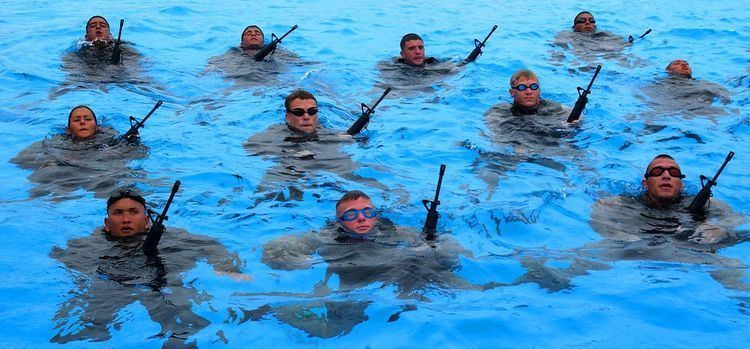 | ||
Treading water or water treading is what a swimmer can do while in a vertical position to keep their head above the surface of the water, while not providing sufficient directional thrust to overcome inertia and propel the swimmer in any specific direction.
Contents
As such, the phrase "treading water" has become a euphemism for an effort expected to create motion, but which actually results in merely staying in one, possibly barely sustainable, place.
Methods
Any sort of movement that allows the swimmer to do this can be classified as treading water, but it is more efficient to move the arms and legs in a specific fashion.
Drowning non-swimmers often splash and kick in an effort to stay above the surface but their lack of technique along with shortness of breath and the panic factor make this a very ineffective method of treading water. They will usually tire quickly and not be able to stay above the surface very long.
More experienced swimmers often find their own method of staying above the surface. These techniques often involve sculling, flutter kick, and other unofficial techniques of staying above the surface.
Eggbeater kick
The eggbeater kick is a highly refined and efficient method of treading water. It involves the swimmer in a "sitting position" in the water. The swimmer's back must be straight, knees bent so that the thighs are parallel to the surface of the water, and lower legs perpendicular to the surface.
The left foot makes a clockwise motion while the right leg makes a counterclockwise motion towards the axis of the body. The legs should never meet because when one foot is on the inside of the motion, the other should be on the outside. The arms are not involved directly in this kick.
The most critical aspect to having an effective egg beater kick is flexibility. You need very good range of motion of the hips to have a good egg beater kick.
Eggbeater kick can be used to move through the water if the body is angled. Because of the opposite motion of the legs, eggbeater is a very smooth and steady way of treading water. It also leaves the hands free to do work if necessary.
This method of treading of water is the preferred method used by lifeguards and other aquatic rescue professionals because of its efficiency and simplicity. The fact that it does not occupy the hands is a major factor in this preference as these professionals often have to perform first aid as they are swimming to safety.
Eggbeater is used in water polo because it lets the athletes use their arms to throw the ball. The eggbeater kick is the primary kick that enables the player to support himself in the water while passing, shooting, defending, and resting – horizontally and vertically. It is also used for getting a quick, explosive start, when the player is beginning to swim. Greater elevation of the Polo player is created by a stronger eggbeater kick which results in a better rotation and stronger pass or shot. Overuse of the eggbeater kick has been a cause of knee injuries in water polo players.
Eggbeater is also used in synchronized swimming for stability and height above the water while leaving the hands free to perform strokes. Using the eggbeater, swimmers can also perform "boosts", where they use their legs to momentarily propel themselves out of the water to their hips or higher.
The dog paddle is a simple style often used instinctively by children. It involves waving both hands & legs randomly while "on all fours".
Another popular style involves sculling water horizontally while using flutter kicks vertically.
